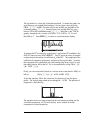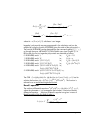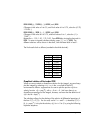
Page 16-53
where ν is not an integer, and the function Gamma Γ(α) is defined in Chapter
3.
If ν = n, an integer, the Bessel functions of the first kind for n = integer
are
defined by
Regardless of whether we use ν (non-integer) or n (integer) in the calculator, we
can define the Bessel functions of the first kind by using the following finite
series:
Thus, we have control over the function’s order, n, and of the number of
elements in the series, k. Once you have typed this function, you can use
function DEFINE to define function J(x,n,k). This will create the variable @@@J@@@ in
the soft-menu keys. For example, to evaluate J
3
(0.1) using 5 terms in the series,
calculate J(0.1,3,5), i.e., in RPN mode: .1#3#5@@@J@@@ The
result is 2.08203157E-5.
If you want to obtain an expression for J
0
(x) with, say, 5 terms in the series, use
J(x,0,5). The result is
‘1-0.25*x^2+0.015625*x^4-4.3403777E-4*x^6+6.782168E-6*x^8-
6.78168*x^10’.
For non-integer values ν, the solution to the Bessel equation is given by
y(x) = K
1
⋅J
ν
(x)+K
2
⋅J
-ν
(x).
For integer values, the functions Jn(x) and J-n(x) are linearly dependent, since
J
n
(x) = (-1)
n
⋅J
-n
(x),
therefore, we cannot use them to obtain a general function to the equation.
Instead, we introduce the Bessel functions of the second kind
defined as
∑
∞
=
+
+⋅⋅
⋅−
⋅=
0
2
2
.
)!(!2
)1(
)(
m
nm
mm
n
n
mnm
x
xxJ


















